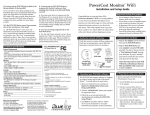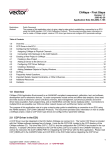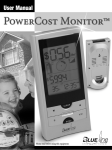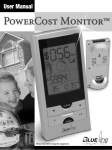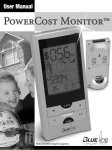Download Blue Line Innovations PowerCost Monitor Installation guide
Transcript
1 PowerCost Monitor ™ Installation Guide 4 Verify the Contents of the Box Verify that your box contains all these components. If any item is missing, please contact your PowerCost Monitor reseller. A Before Proceeding Before attempting to configure the WiFi bridge device ensure that your wireless router is configured to allow 802.11b protocol and that “Access” or “MAC” filtering is disabled. If you are unclear about these settings please see the FAQs section at the end of this document or contact the person who initially configured your router. nitor ™ Welcome o Cost M Power Guide Sensor Unit monitoring . electricity-is consuming a new in the hold tor™, ctions Moni your house rCost the instru Powe electricity e follow of the amount of Pleas the for use. e on your purchase ready time of Welcom tions s you in real your system safety . ion, Congratula inform how to get that any steps necessary In addit device explainsut skipping r Unit. take all day and ling the Senso This Guide n witho a dry show autions r Unit on r for instal . order Prec Senso ty times a ladde nt SaferCost Monitor need to use s below at all . unit. Importa if you instruction any liquid Monitor your Powe ularly local waste unit in rCost safety partic Install tor your s, the Powe rty Moni with either r prope precaution and apply PowerCostn impact to in accordance , and/o read so burns please rse either sudde tor, do injuries, materials. not imme or cause anyrCost Moni cause any fluid sive Do If . can ➢ They and corroyour health it off with not drop the Powe ➢ Dodisposing of ts, heat, batteries. ful to s. y wash handling metal objeccan be harm immediatel ➢ If sal regulation s when that ct with dispo entally, precaution of conta leak fluids it accid Monitor. ➢ Take ge as a resultdisplay mayafter you drop rCost dama ged LCD Unit your Powe Display dama e using ➢ A from the . lly befor leaks s carefu water soap and the instruction ay all Displ ➢ Read Unit item If any onents. reseller. comp these Monitor ins all rCost box conta your Powe e ct that your n Guid llatio Verify ng, please conta e Insta Guid is missi and User ion Installat (with clamping strap) US AT ST Congratulations on your purchase of the PowerCost Monitor™, a new electricitymonitoring device that informs you in real time of the amount of electricity your household is consuming. This Guide explains how to get your system ready for use. Please follow the instructions in the order shown without skipping any steps. ET RES 1 the Con Verify of the tents Box STATUS er Shim RESET Rubb late ment Temp Align or Unit Sensclamping strap) (with + _ _ _ _ Clear ries + + + ine “AA” Batte Alkal Important Safety Precautions Installation Guide Install your PowerCost Monitor Sensor Unit on a dry day and take all necessary safety precautions, particularly if you need to use a ladder for installing the Sensor Unit. In addition, please read and apply the safety instructions below at all times. PowerCost Monitor WiFi (PCM WiFi) ➢ Do not immerse either PowerCost Monitor unit in any liquid. ➢ Do not drop or cause any sudden impact to either PowerCost Monitor unit. ➢ If disposing of the PowerCost Monitor, do so in accordance with your local _ AC adaptor Note: The status LED on your PCM WiFi device will alternate between RED and GREEN while connected to your computer DO NOT remove the grease from around the battery lid. This grease helps protect the internal components from moisture. C Download Your PCM WiFi Software The PCM WiFi unit requires software to configure its wireless features. To install, follow the steps below: 1.Open your Internet browser and type in: http://www.bluelineinnovations. com/Downloads/PCMWiFi/iris/publish.htm 2.After accepting the license agreement click INSTALL to download the PCMWiFi software. 3. Find your meter’s power factor and write it down in the box labeled “Power Factor” next to the illustration below which matches your meter. Your meter’s power factor is indicated on the face of the meter, most often next to the letters Kh (less often the letters Ks or Kt). In most cases, your meter’s power factor is 7.2 if it has dials and a spinning disk, or 1.0 if it has a digital readout. STEP 1: UPDATING THE DEVICE SOFTWARE The installation wizard will verify the software version in your PCM WiFi device. If your device requires updating the Wizard will inform you and let you know if 1 or 2 updates will be required. During the updating process you may be prompted to disconnect and reconnect the USB cable. It is very important to disconnect the cable only when prompted to do so during the process. Disconnecting the USB cable at the incorrect time during the update process can render your device inoperative. STEP 2: CONFIGURE THE WIRELESS SETTINGS Using the information from Step A of this section enter the name of your wireless network (SSID), your security type and your passphrase (if not using Open Security). If you do not know this information you can obtain it from the wireless setting section of your router. If you are unsure of how to obtain this information please contact the person who initially configured your router. Once you have entered the settings for your wireless network click NEXT. STEP 3: SET YOUR ELECTRICITY METER POWER FACTOR Using the information you collected in Section 2 (Determine Your Meter Type and Power Factor), enter the Power Factor value for your meter. The PCM WiFi bridge device uses this value to correctly calculate your energy usage. This value must be between 1.0 and 99.9. After entering this number click NEXT. STEP 4: PAIRING THE PCM WIFI AND SENSOR Disconnect your PCMWiFi device and move it to a permanent indoor location as close as is practical to your electricity meter. After connecting the AC adapter wait 30 seconds then press the SYNC button on top of the unit for approximately 6 seconds until the status LED turns solid red. Release the SYNC button, then return to your sensor unit and press and release the RESET button on the sensor. Click NEXT on your computer. 3.Follow the on-screen instructions for downloading and installing the PCM WiFi Setup Wizard. Type 3 Meter: Electronic with optical port on the face, less than 1.5 inches from the outer rim 5 Prepare Your Sensor Unit On these electronic meters, the optical port is on the face, located less than 1.5 inches (37 mm) from the meter’s outer rim. This type of meter requires that you mount the supplied rubber shims on the underside of the Sensor Unit. Type 3 Meter: Electronic with optical port on the face, 1.5 inches maximum from the outer rim G A Clamp B Sensor Arm (pulled out) C B If in doubt, measure the distance using the ruler below. 2. Determine which of the following illustrations most closely matches your meter. Remember your meter type. D Configuring the WiFi Bridge Follow the on-screen instructions to complete the software update. When the update is complete click NEXT. Rubber Shim Install the Batteries in the Sensor Unit Determine Your Meter Type and Power Factor INSTRUCTIONS: To determine your meter type, study the illustrations and descriptions below. 1. Locate your electricity meter. Open WEP WPA/WPA2 2. Plug the PCM WiFi device into your computer using the USB cable provided. You may or may not receive a “New Hardware Found” message from Windows. If you do, Windows may want to restart after you connect your device for the first time. Restart you computer if prompted to do so, before proceeding to Step C. Insert two AA batteries in the orientation indicated by the + and – signs printed on the circuit board, then close and lock the battery compartment by turning the screw clockwise. Do not overtighten. The red STATUS indicator should illuminate within 10 seconds. In some cases, it may be necessary to adjust your Sensor Unit to fit your particular meter. Therefore, it is extremely important to determine exactly what kind of meter is installed on your premises. Security type: It is recommended that you setup your PCM WiFi device from a PC that is using a wireless connection. This will assist in determining your network configuration. 1. Plug the AC adaptor into the wall and then into the PCM WiFi device. + 2 Alkaline “AA” Batteries Turn the screw counterclockwise to open the Sensor Unit battery compartment cover. 3 Passphrase: USB cable _ + 2 Record your router’s wireless settings here: Network name (SSID): B Connect Your Hardware Clear Alignment Template waste disposal regulations. ➢ Take precautions when handling batteries. They can cause injuries, burns, and/or property damage as a result of contact with metal objects, heat, and corrosive materials. ➢ Read all the instructions carefully before using your PowerCost Monitor. Configure the WiFi Bridge F E C Sensor Head D 1 Perform the same steps as described for a Type 2 meter. 2 Peel off the adhesive backing from the shim. 3 Position the shim on the underside of the Sensor Unit casing with the adhesive side down. 4 Press the shim in place onto the underside of the Sensor Unit casing. D Sensor LEDs (dark and white) E Wire Power Factor 4 F Wire Cavity G Sensor Arm Latch A Type 1 Meter: Electromechanical This type of meter has dials and a spinning disk. 9 0 1 9 0 1 8 2 7 3 654 8 2 7 3 654 9 0 1 8 2 7 3 654 or 10 9 2 8 3 7 456 9 0 1 8 2 7 3 654 The Sensor Unit reads the revolutions of the disk and transmits that information to the PCMWiFi unit. Instructions: Perform the operations in the block that corresponds to your meter type. When you are done, go to Step 9 - Install your Sensor Unit. Type 1 Meter: Electromechanical 1 Open the Sensor Arm latch G by pulling upward. Power Factor 2 Extend the Sensor Arm B to its full length by pulling on it firmly, but gently. If you accidentally pull it out completely, push it back into the casing. Type 2 Meter: Electronic with optical port on the face, 1.5 inches or more from the outer rim Type 4 Meter: Electronic with optical port on the top On this type of meter, the optical port is located at least 1.5 inches (37 mm) from the meter’s outer rim. On this type of meter, the optical port is located on the top portion of the meter. If in doubt, measure the distance using the ruler below. This kind of meter requires you to reconfigure the Sensor Unit and install the Clear Alignment template. NOTE: The optical port can be located at either the right (3 o’clock), or left (9 o’clock) position on your meter. Power Factor 3 Close the latch G . Type 2 Meter: Electronic with optical port on the face, 1.5 inches or more from the outer rim 1 Open the Sensor Arm latch G by pulling upward. 2 Ensure that the Sensor Arm B is pushed in as far as it will go into the body of the Sensor Unit. Power Factor ruler 3 Close the latch G . Type 4 Meter: Electronic - optical port on top 1 Open the Sensor Arm latch G by pulling upward. 2 Gently pull the Sensor Arm B completely out of the Sensor Body. 3 Turn over the Sensor Arm B . 4 Push the thin end of the Sensor Arm B upwards through the latch opening and press the Sensor Arm firmly into the cavity. 5 Firmly push the Sensor Head C behind the strap, and as far down as it will go into the bottom cavity of the body. The dark Sensor Head LED D must be clearly visible below the clamp. If necessary, use a dull pointed object, such as a ballpoint pen to push the head C downwards. Tuck the wire E into the side cavity F . 6 7 Close the latch G . 6 Install Your Sensor Unit START – Read SAFETY PRECAUTIONS first IMPORTANT: Turn on a high energy-consuming appliance in your house, such as your electric stove or dryer. This will temporarily increase your electricity consumption and enable the Sensor Unit to begin reading your meter’s output in less time. 1. Go to your meter, taking the following items with you: ➢ This Guide ➢ Sensor Unit ➢ A clean damp cloth ➢ 1 large Flat Head screwdriver ➢ Clear Alignment Template (if you have a Type 4 meter) ➢ Stepping stool or ladder if your utility meter is located higher than eye level. DO NOT USE A CHAIR OR OTHER UNSTABLE PLATFORM. 2. Perform the installation steps for your type of meter (which you determined in Section 3). 1. Stand directly in front of your meter, at a height where you can see the optical port. The optical port itself looks like a small protruding pipe in the center of the top portion of the meter. Carefully wipe the meter dome clean with the damp cloth. 2. Hold the template with the protruding tab facing you and the white arrow pointing away from you. Peel off the adhesive backing. 1.After carefully wiping the meter dome clean with the damp cloth, fit the Sensor Unit over your utility meter as shown, so that the Sensor Head C sits as close as possible to the front of the glass dome. 6. Tighten the hose clamp A until the Sensor Unit is snug, but can move just enough to allow for adjustments. 2.With your screwdriver, tighten the hose clamp A until the Sensor Unit is snug, but can move just enough to allow for slight adjustments. 7. Open the Sensor Arm latch G and sight down the opening. You see a vertical plastic tab painted white on the inside of the Sensor body. 3.Position the Sensor Head C : 8. Sighting through the opening, position the Sensor Unit so that the white plastic tab on the body is aligned with the arrow on the template. TYPE 1 Meters: Position the Sensor Arm B so that it is inline with the spinning disk (use the line on the Sensor Arm as a reference) and the Sensor Head C is on or near the center of the meter. TYPES 2, 3 Meters: Position the Sensor Arm B so that the dark LED D in the Sensor Head C is located exactly above the optical port. or... optical port is on the left TYPE 1 - After approximately 20 seconds, the red STATUS indicator turns off and within two minutes, it starts flashing once per disk revolution. This is an indication that your Sensor Unit is correctly reading the meter. Q. I’ve attempted to re-connect my PCM WiFi device and sensor unit but the status LED is still AMBER. A. It is possible that your sensor unit ID has changed, which can occur if you hold the sensor RESET button down for approximately 5 seconds. Press and hold the SYNC button on your PCM WiFi device for 5 seconds until the RED status LED illuminates. Then press and release the RESET button on your sensor unit. This will connect the two devices with the new sensor ID. 10.Keeping the white lines on the body and template aligned, slowly and gently push or pull on the Sensor Unit until the red STATUS indicator starts flashing regularly, indicating that the Sensor Unit has detected the signal from your meter. Within 1 minute, in addition to the regular flashing, you should see an extra flash every now and then, depending on your rate of electricity consumption. These extra flashes are normal, and indicate that the Sensor Unit is reading the meter’s output correctly. Q. Can I see the status of my PCM WiFi device from my computer? Note 1: The STATUS indicator stops flashing after 2 minutes, in order to maximize battery life. If you have not seen at least one extra flash by then, please read the Troubleshooting section in your User Guide. 4.Press and release the RESET button. The red STATUS indicator turns on solid. 5.If you positioned the Sensor Head C correctly, the STATUS indicator starts flashing as indicated below. If it does not, correct the positioning slightly. Also, your wireless network must support the 802.11b Wi-Fi protocol. Many new routers have this feature turned off and you should turn it on. See your router’s documentation for instructions on doing this. 9. Press the RESET button and wait 10 seconds. The red STATUS indicator turns on solid. the sensor head “rib” closest to the tip must align with the leftmost hole Note 2: If the STATUS indicator doesn’t flash at all and stays lit solid, prepeat the steps above and recheck for proper alignment. 7 If you do not see your problem listed here, or you are still unable to get your system working properly, more information is available at http://www.bluelineinnovations.com/Products/PCM WiFi. You may also send an email to [email protected] describing the difficulty you are having or call us toll-free at 1-866-607-2583. A. The most likely cause is that you might have entered incorrect information about your wireless home network during device setup. Run the PCM WiFi Setup Wizard again and ensure that the wireless settings of the PCM WiFi device exactly match the settings of your wireless router, especially the passphrase. To see the letters you type, clear the “Hide characters” check box in the PCM WiFi Setup Wizard. 4. Carefully stick the template to the dome, pressing it in place on top first, then on the protruding tab down the front of the dome. Type 1, 2 & 3 Meters: Frequently Asked Questions Q. I can’t get my device to connect to my wireless network. 3. Position the template on the meter so that the horizontal white line on the template follows the front edge of the meter dome, and the white arrow points straight to the optical port. 5. Slide the Sensor Unit over the glass dome and align the edges of the Sensor Unit body with the white side lines. optical port is on the right 8 Type 4 Meters: Connecting your PCMWiFI to the Lowe’s Iris Service ™ A. Yes. Open a web browser and type: http://pcmwifi and the device home page will appear. Note: if you changed the name of your PCM WiFi device, then type: http://yourdevicename (e.g., http:// mypcmwifi). Q. The last reading from the PowerCost Monitor sensor was more than 32 seconds ago. Is this a problem? A. If your “Last Reading Time” is occasionally more than 32 seconds check the “Signal Quality” on the PCM WiFi Status page. If it is less than 100% it is likely that your PCM WiFi is on the edge of its range limit. Move it closer to the PowerCost Monitor sensor unit. It is also possible that the batteries in your sensor unit are getting weak and may need to be replaced. Q. Can I update the software in my PCM WiFi device while it is connected to my wireless network? A. No. In order to install an update in your device you must attach it to your computer using a USB cable and use the PCM WiFi Setup Wizard. When you start the wizard it will automatically check for available updates and give you the opportunity to install them. Q. I want to set my PCM WiFi device back to the factory defaults. Is that possible? A. Yes. In order to erase all the settings in your PCM WiFi device press and hold the SYNC button on the top of the unit for 30 seconds until the RED status LED comes on solid, then release the button. Rerun the PCM WiFi Setup Wizard to configure it again. Q. Is the PCM WiFi device secure? Can someone else see how much power I am using? A. If your wireless network is open (e.g., no security is used) then the PCM WiFi device will not show any energy usage when accessed from a web browser. Q. Can I see my energy usage directly on my PCM WiFi device A. Yes, but only if your network is secure. If you network uses “Open” security the device will not display your energy usage. Where possible it is always best to secure your network to keep your personal information private. Technical Specifications PowerCost Monitor Sensor Unit System Requirements Power 2. Log into your Iris™ dashboard at lowes.com/iris · Wi-Fi accessible broadband internet connection with 802.11b support · PC or laptop with Windows® XP SP3 (or later) · Blue Line Innovations PowerCost Monitor · 2 AA Alkaline Batteries (LR6 or equivalent) · 2 AA Lithium Batteries for temperatures consistently below -20 ºC Note 1: The STATUS indicator stops flashing after approximately 2 ½ minutes, in order to maximize battery life. 3.Select DEVICES and then ADD DEVICES. Wireless 4. Click on the Blue Line Power Meter icon. Note 2: If the STATUS indicator does not flash at all and stays lit solid, repeat the steps above and recheck for proper alignment. 5. Follow the on-screen instructions. The Iris™ hub will find your Blue Line meter reader and add it to your service. · 802.11B MAC (802.11B/G and 802.11n Draft 2.0 compatible) · Up to 2Mbps data rate · Power Output +10dBm (10mW) Follow the steps below to connect your PCMWiFi device to the Lowe’s Iris™ service: 1 Ensure that you have successfully completed all previous steps to install your PCMWiFi and sensor, and that it is operating normally. Security · 40/60-, 128-, 152-bit WEP · Wi-Fi Protected Access (WPA/WPA2) · Secure Socket Layer (SSL) upload to Lowe’s Iris™ Configuration & Management · PC application to configure Wi-Fi settings and update firmware Physical Dimensions: · 125mm diameter X 45mm (5” diameter X 1.5”) · 180g (6.7oz) not including AC adapter Power · 100v-240v AC · 6.4W max A. The illustrations in Section 3 of this guide represent various kinds of meters that we have grouped arbitrarily under “types”, based on different sequences of operations that are required to mount a Sensor Unit correctly. The majority of existing meters fall under one of these generic types. Determine which illustration most closely matches your meter, and remember to follow the installation instructions for that meter type. Also find the meter’s power factor on the face of the meter and write it in the box labeled “Power factor”. The power factor is a number (usually 1.0 or 7.2) preceded by two letters (usually Kh or Ks or Kt). Proceed with the installation steps in order and, in Section 6 specifically, follow the installation instructions for that meter type. Q. After installing the Sensor Unit on my meter and pressing the RESET button, nothing happens. The red indicator does not light up. A. The STATUS light in the Sensor should light up solid red within 10 seconds after pressing the RESET switch. If it does not, try these steps: 1.Confirm that the batteries are inserted in the correct orientation. + and – symbols are printed on the green circuit board inside the battery compartment. Q. My Sensor Unit STATUS LED is flashing regularly, but every now and then, there is an extra flash. Is there anything wrong with my unit? A. This is exactly what you should see and indicates that the sensor unit is detecting information from your meter. If you don’t see an irregular flash every now and then, try turning on an appliance that consumes a lot of electricity and check again. Q. The Sensor Battery indicator shows a low battery level, but I installed fresh batteries not long ago. A. Regular alkaline batteries can become exhausted very rapidly when it is extremely cold outside. If you are expecting an extended period of temperatures below -20°C (-4°F), try using lithium type AA batteries in the Sensor Unit. These batteries are commonly available and they provide better performance in cold. Q. The Sensor Unit appears to have detected my meter properly, but the PCM WiFi bridge is not receiving any information. A. Ensure that the PCM WiFi bridge device is located within 100 feet (30m) of the Sensor Unit. Note that each wall of your house reduces the range by approximately 15 feet (5m). Also, aluminium siding on your house will significantly reduce the range. If this is the case, try to position the PCM WiFi unit so that there is a window between it and the Sensor Unit. 2.Confirm that the batteries are not dead. We recommend lithium batteries for longer life in freezing conditions. If neither range nor wall construction seem to cause be the problem, repeat Step 4 in “D” of Section 4 to re-synchronize your PCMWiFi device and Sensor Units. 3.Confirm that the battery lid is closed and screwed down. The lid has to be fastened down for the batteries to make contact. Lastly, it is possible that the batteries in the Sensor Unit are exhausted. Replace the batteries with fresh ones. Q. The red STATUS indicator on my Sensor Unit is flashing rapidly. Is this the indication of a problem? A. The STATUS indicator starts flashing very rapidly if the Sensor Unit still has not detected the signal of a meter within 20 minutes. If this happens check your alignment, then press the RESET button again and wait 10 seconds for the STATUS indicator to light up solid. You can then proceed with the installation as described. WARRANTY - PCM WiFi TYPES 2 and 3 - Within 20 seconds, the red STATUS indicator starts flashing regularly, indicating that the Sensor Unit has detected the signal from your meter. Within 1 minute, in addition to the regular flashing, you should see an extra flash every now and then depending on your rate of electricity consumption. These extra flashes are normal and indicate that the Sensor Unit is reading the meter’s output correctly. Q. I am unsure of my utility meter type. How can I find out which type of meter I have? Wireless Communications Frequency433.92MHz Update Rate Approximately every 30 seconds Range Up to 30m (100ft.) line-of-sight (Subtract 5m or 15 feet for each wall between Display and Sensor Units) Operating Temperature Range Sensor Unit -40°C to 60°C (-40°F to 140°F) LIMITED ONE YEAR WARRANTY Blue Line Innovations warrants this product to be free from defects in materials and workmanship for a period of one year from the date of sale to the original user or consumer purchaser. Blue Line Innovation’s exclusive obligation under this warranty shall be, at its option, (a) to supply, without charge, a replacement of the product or (b) to refund the purchase price in respect of any product that is found to be defective and that is returned, with its proof of purchase, to the original supplier. This warranty excludes and does not cover defects, malfunctions, or failures caused by misuse, unauthorized repairs, modifications or accidental damage. Note: This warranty does not apply to batteries or damage to the product caused by the use of faulty batteries. Warning: Changes or modifications not expressly approved by Blue Line Innovations Inc. void the user’s authority to operate the equipment. This warranty is only applicable to a product purchased through a Blue Line Innovations authorized dealer. In no event shall Blue Line Innovations be liable for consequential or incidental damages. This warranty is in lieu of all other expressed warranties. The duration of any implied warranty is limited to the period of the expressed warranty set forth above. Blue Line Innovations Inc. 187 Kenmount Road 1st Floor, ICON Building St. John’s, NL Canada A1B 3P9 [email protected] www.bluelineinnovations.com Toll Free: 1-866-607-2583 © 2012. Blue Line Innovations Incorporated. All rights reserved. Information in this document is subject to change without notice. Blue Line Innovations and PowerCost Monitor are trademarks of Blue Line Innovations Incorporated. All other trademarks are the property of their respective owners. Printed in China. PN BLI-00334R001


